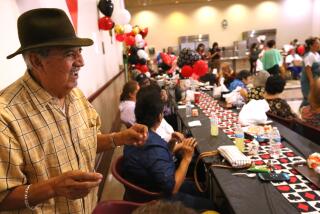Census outreach is key in L.A.
With sprawling enclaves of immigrants, crowded housing conditions and pockets of deep poverty, Los Angeles is regarded as the nationâs most difficult county for census-takers to count.
But as they gear up for the decennial census beginning in April, officials are beefing up efforts to reach the regionâs far-flung polyglot communities with more community outreach staff and language assistance, including a first-ever bilingual English-Spanish census form.
At a meeting last week in downtown Los Angeles, U.S. census officials met with Gov. Arnold Schwarzenegger, dozens of community activists, nonprofit leaders and state and local government representatives to craft strategies on how to reach the 4.4 million people who live in âhard-to-countâ neighborhoods in Los Angeles County.
Census officials give that designation to areas where residents traditionally have low rates of census participation, including immigrants with limited English, African Americans and other minority groups, the poor, the less educated and those who live in crowded housing.
Los Angeles Countyâs hard-to-count population dwarfs those in all other U.S. counties and is concentrated in the cityâs central core, from Sunset Boulevard to Imperial Highway, the Terminal Island area and parts of the San Fernando Valley.
Officials fear funding shortages and mistrust toward the government among many immigrants could result in an undercount with enormous consequences for California: the possible loss of a U.S. congressional seat for the first time in state history and the loss of billions of dollars of federal funding for schools and other services.
Congressional seats and more than $300 billion in federal funding for more than 170 programs are apportioned by population, as determined by the census. By some estimates, each person counted results in $12,000 in federal funds over a decade.
âThis is the most important census in California history,â said Ditas Katague, state census director.
Fueling the worries about an undercount next year is a sizable drop in state funding for outreach efforts: $3 million for next year, compared with $24.7 million in 2000.
James T. Christy, the U.S. Census Bureauâs Los Angeles regional director, said the federal government has stepped in with some increased funding. It has expanded the number of Los Angeles community outreach staff to more than 350 people from 50 in 2000 and is offering informational guides in 59 languages, an increase of more than 20%. The new languages include Polish, Russian and Arabic. In addition, Russian has been added to the telephone assistance system, which also operates in English, Spanish, Chinese, Korean and Vietnamese.
Nonprofit organizations have also tried to fill the gap. The California Endowment, which sponsored the census forum, announced last week that it would provide $4 million for statewide outreach, and the California Community Foundation had earlier announced grants of $1.5 million.
But Christy said the financial woes remain worrisome. âCommunity-based organizations donât have the funding to tack on a census message,â he said.
Christy also said that next yearâs census, the first since the 9/11 terrorist attacks, could be met with suspicion from minorities who may be wary of government intrusion into their lives. He said the Justice Department had assured the bureau that the Patriot Act, which gave law enforcement broader access to personal information for counter-terrorism investigations, could not be used to force the surrender of any census information. The U.S. Supreme Court has also ruled that census information must remain confidential, he said.
âNo one can get access to census data,â Christy said. âIt is rock solid secure.â
To address such concerns, census officials are expanding their outreach staff and dispatching âcomplete countâ committees made up of local government officials and community members. Committees have been formed by Cambodians, Koreans, Filipinos and Sikhs, among others. Officials are pitching the census as âsafe, easy and important,â noting that the formâs 10 questions will not ask for Social Security numbers or legal status.
Community members are also doing their own outreach. Nadiya Littlewarrior, a Native American gourd artist who attended the census meeting, said she was helping design T-shirts featuring tribal motifs to promote the census.
Sharon R. Blackburn of the South Central Prevention Coalition, a network of social service providers, said she has already passed out census information at local jazz festivals and planned âcensus partiesâ at several low-income housing units. Blackburn said African Americans have traditionally been undercounted, in part because some decline to participate, fearing their information could be used to deny welfare payments or alert credit agencies or law enforcement to their whereabouts.
Dan Ichinose of the Asian Pacific American Legal Center in Los Angeles said his group plans to produce information for the first time in Samoan and Tongan, among other efforts. A UCLA study of the 2000 census estimated that as many as 175,000 Asians and Pacific Islanders were not counted, costing the state $2.1 billion in federal funding, he said.
--
More to Read
Sign up for Essential California
The most important California stories and recommendations in your inbox every morning.
You may occasionally receive promotional content from the Los Angeles Times.





![[20060326 (LA/A20) -- STATING THE CASE: Marchers organized by unions, religious organizations and immigrants rights groups carry signs and chant in downtown L.A. "People are really upset that all the work they do, everything that they give to this nation, is ignored," said Angelica Salas of the Coalition of Humane Immigrant Rights. -- PHOTOGRAPHER: Photographs by Gina Ferazzi The Los Angeles Times] *** [Ferazzi, Gina -- - 109170.ME.0325.rights.12.GMF- Gina Ferazzi/Los Angeles Times - Thousands of protesters march to city hall in downtown Los Angeles Saturday, March 25, 2006. They are protesting against House-passed HR 4437, an anti-immigration bill that opponents say will criminalize millions of immigrant families and anyone who comes into contact with them.]](https://ca-times.brightspotcdn.com/dims4/default/34f403d/2147483647/strip/true/crop/1983x1322+109+0/resize/840x560!/quality/75/?url=https%3A%2F%2Fcalifornia-times-brightspot.s3.amazonaws.com%2Fzbk%2Fdamlat_images%2FLA%2FLA_PHOTO_ARCHIVE%2FSDOCS%2854%29%2Fkx3lslnc.JPG)





